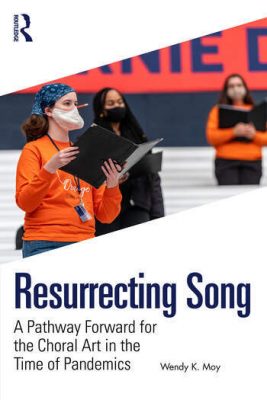In her new book, Wendy Moy, Professor of Music Education in Syracuse University’s College of Visual and Performing Arts and School of Education, brings together first-person accounts to offer a sometimes heartbreaking, many times joyful portrait of how choral musicians weathered the coronavirus pandemic.
 In doing so, Resurrecting Song: A Pathway Forward for the Choral Art in the Time of Pandemics (Routledge, 2024) illustrates how the choral music community journeyed through crisis to rebuild itself in an new era.
In doing so, Resurrecting Song: A Pathway Forward for the Choral Art in the Time of Pandemics (Routledge, 2024) illustrates how the choral music community journeyed through crisis to rebuild itself in an new era.
Moy will celebrate her new publication on April 3, 2024, with a book launch in the Peter Graham Scholarly Commons, Bird Library Room 114, Syracuse University, from 4:45 to 6 p.m.
When former American Choral Directors Association Executive Director Tim Sharp learned of Moy’s research, he noted that, “It’ll be interesting, and I think important, to document this. In 10 years, we’ll look back and maybe see more clearly what we were up against and what we did, and hopefully, what we did better and what we lost.”
Moy interviewed more than 40 choral musicians from across the United States and Canada and from a spectrum of contexts: community choruses, professional choirs, children and youth choirs, school choirs, and choral organizations.
The subjects of Resurrecting Song went from being advocates and educators of choral singing to literally “saving the choral art.”
“The singers and directors shared with me what it was like to make choral music during the COVID-19 pandemic,” says Moy. “This book documents these interviews. It was heartbreaking to hear personal stories of what they went through as people, as educators, and as musicians. There was a lot of loss.”
When the pandemic emerged in early 2020, the impact on choral music was immediate and devastating. The act of gathering and singing together became a source of contagion and potential severe illness or death.
 “Nevertheless, it was inspiring to hear how new ideas came about to help singers overcome during a time when singing was deemed a ‘superspreading’ activity,” observes Moy. “Resurrecting Song documents how singing became a source of joy during tragic circumstances. It was wonderful to connect human to human through these stories.”
“Nevertheless, it was inspiring to hear how new ideas came about to help singers overcome during a time when singing was deemed a ‘superspreading’ activity,” observes Moy. “Resurrecting Song documents how singing became a source of joy during tragic circumstances. It was wonderful to connect human to human through these stories.”
Documenting both pandemic experiences and the lessons learned from surviving and thriving, Moy’s book showcases the resilience of choral music and helps point the way to new directions for the choral community in the wake of the pandemic.
In their own words, we hear how the community banded together to innovate, use technology in new ways, and generate changes to practice. Moy also explores how the pandemic caused many directors to realize the need to create a more inclusive place of belonging in their rehearsals, and it provides reflections on the philosophy of singing and creating a choral community.
As Moy puts it, during the challenging months of COVID-19 the subjects of Resurrecting Song went from being advocates and educators of choral singing to literally “saving the choral art.”
